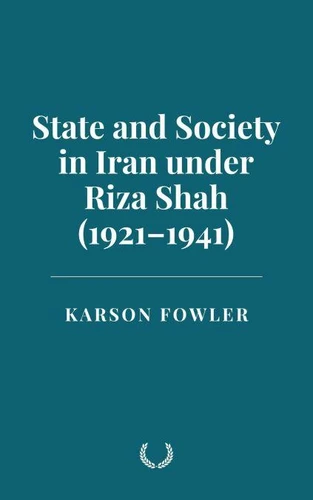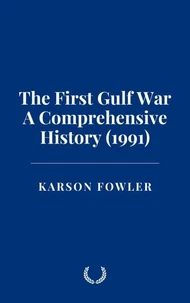State and Society in Iran under Riza Shah (1921–1941)
Par :Formats :
Disponible dans votre compte client Decitre ou Furet du Nord dès validation de votre commande. Le format ePub est :
- Compatible avec une lecture sur My Vivlio (smartphone, tablette, ordinateur)
- Compatible avec une lecture sur liseuses Vivlio
- Pour les liseuses autres que Vivlio, vous devez utiliser le logiciel Adobe Digital Edition. Non compatible avec la lecture sur les liseuses Kindle, Remarkable et Sony
 , qui est-ce ?
, qui est-ce ?Notre partenaire de plateforme de lecture numérique où vous retrouverez l'ensemble de vos ebooks gratuitement
Pour en savoir plus sur nos ebooks, consultez notre aide en ligne ici
- FormatePub
- ISBN8230386339
- EAN9798230386339
- Date de parution27/01/2025
- Protection num.pas de protection
- Infos supplémentairesepub
- ÉditeurIndependently Published
Résumé
This book examines the complex and transformative history of Iran under the rule of Reza Shah Pahlavi (1921-1941) and the subsequent political, social, and ideological shifts that culminated in the 1979 Islamic Revolution. It explores the rise of Reza Shah, his efforts to modernize and centralize Iran, and the authoritarian methods he employed to reshape the country, including his push for secularization, military expansion, and infrastructure development.
The book delves into the consequences of his rule, analyzing the deep social divisions, political repression, and cultural resistance that emerged in response to his policies. Following Reza Shah's abdication, the book traces the rise of his son, Mohammad Reza Pahlavi, and the continuation of his father's vision of modernization and centralization, alongside growing opposition from both religious and secular factions.
The narrative unfolds through the tensions that marked the Pahlavi dynasty's rule, from economic inequality and authoritarianism to the increasing dissatisfaction of various social groups. The eventual decline of the Pahlavi regime is contextualized within the larger geopolitical dynamics of World War II and the Cold War, with a focus on the Islamic Revolution of 1979 and the political rise of Ayatollah Khomeini.
Through detailed analysis of primary sources, historical events, and key ideological movements, the book provides a comprehensive account of the Pahlavi era's legacy, the rise of political Islam, and the establishment of the Islamic Republic. It offers insight into the forces that both shaped and opposed the revolution, and how the Islamic Republic's subsequent political evolution continues to influence Iran's governance and global relations today.
Ultimately, the book reflects on the contradictions of Reza Shah's modernizing ambitions, the complexities of the Islamic Republic's foundations, and the ongoing political and cultural struggles that have defined modern Iran.
The book delves into the consequences of his rule, analyzing the deep social divisions, political repression, and cultural resistance that emerged in response to his policies. Following Reza Shah's abdication, the book traces the rise of his son, Mohammad Reza Pahlavi, and the continuation of his father's vision of modernization and centralization, alongside growing opposition from both religious and secular factions.
The narrative unfolds through the tensions that marked the Pahlavi dynasty's rule, from economic inequality and authoritarianism to the increasing dissatisfaction of various social groups. The eventual decline of the Pahlavi regime is contextualized within the larger geopolitical dynamics of World War II and the Cold War, with a focus on the Islamic Revolution of 1979 and the political rise of Ayatollah Khomeini.
Through detailed analysis of primary sources, historical events, and key ideological movements, the book provides a comprehensive account of the Pahlavi era's legacy, the rise of political Islam, and the establishment of the Islamic Republic. It offers insight into the forces that both shaped and opposed the revolution, and how the Islamic Republic's subsequent political evolution continues to influence Iran's governance and global relations today.
Ultimately, the book reflects on the contradictions of Reza Shah's modernizing ambitions, the complexities of the Islamic Republic's foundations, and the ongoing political and cultural struggles that have defined modern Iran.
This book examines the complex and transformative history of Iran under the rule of Reza Shah Pahlavi (1921-1941) and the subsequent political, social, and ideological shifts that culminated in the 1979 Islamic Revolution. It explores the rise of Reza Shah, his efforts to modernize and centralize Iran, and the authoritarian methods he employed to reshape the country, including his push for secularization, military expansion, and infrastructure development.
The book delves into the consequences of his rule, analyzing the deep social divisions, political repression, and cultural resistance that emerged in response to his policies. Following Reza Shah's abdication, the book traces the rise of his son, Mohammad Reza Pahlavi, and the continuation of his father's vision of modernization and centralization, alongside growing opposition from both religious and secular factions.
The narrative unfolds through the tensions that marked the Pahlavi dynasty's rule, from economic inequality and authoritarianism to the increasing dissatisfaction of various social groups. The eventual decline of the Pahlavi regime is contextualized within the larger geopolitical dynamics of World War II and the Cold War, with a focus on the Islamic Revolution of 1979 and the political rise of Ayatollah Khomeini.
Through detailed analysis of primary sources, historical events, and key ideological movements, the book provides a comprehensive account of the Pahlavi era's legacy, the rise of political Islam, and the establishment of the Islamic Republic. It offers insight into the forces that both shaped and opposed the revolution, and how the Islamic Republic's subsequent political evolution continues to influence Iran's governance and global relations today.
Ultimately, the book reflects on the contradictions of Reza Shah's modernizing ambitions, the complexities of the Islamic Republic's foundations, and the ongoing political and cultural struggles that have defined modern Iran.
The book delves into the consequences of his rule, analyzing the deep social divisions, political repression, and cultural resistance that emerged in response to his policies. Following Reza Shah's abdication, the book traces the rise of his son, Mohammad Reza Pahlavi, and the continuation of his father's vision of modernization and centralization, alongside growing opposition from both religious and secular factions.
The narrative unfolds through the tensions that marked the Pahlavi dynasty's rule, from economic inequality and authoritarianism to the increasing dissatisfaction of various social groups. The eventual decline of the Pahlavi regime is contextualized within the larger geopolitical dynamics of World War II and the Cold War, with a focus on the Islamic Revolution of 1979 and the political rise of Ayatollah Khomeini.
Through detailed analysis of primary sources, historical events, and key ideological movements, the book provides a comprehensive account of the Pahlavi era's legacy, the rise of political Islam, and the establishment of the Islamic Republic. It offers insight into the forces that both shaped and opposed the revolution, and how the Islamic Republic's subsequent political evolution continues to influence Iran's governance and global relations today.
Ultimately, the book reflects on the contradictions of Reza Shah's modernizing ambitions, the complexities of the Islamic Republic's foundations, and the ongoing political and cultural struggles that have defined modern Iran.





